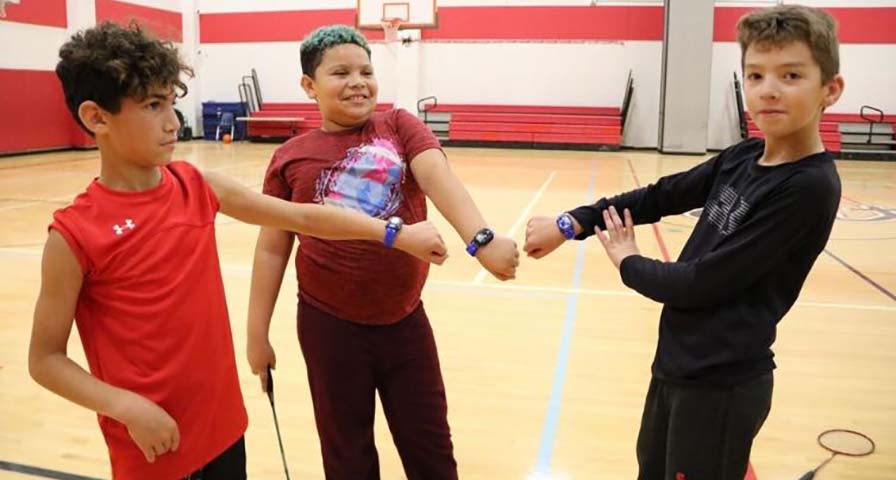Students who wear spirit ZONE heart rate monitors while exercising are learning to maximize their fitness opportunities by staying in their target heart rate zones throughout their workout.
The heart rate monitor’s real-time feedback shows students of all ages which heart rate zone they are exercising in at a given time in their workout. Physical education teachers are using that feedback to create intrinsic learning opportunities, where students can exercise in their target heart rate zones even when they don’t have a monitor to use during a workout.
That’s the ultimate goal, said New York based PE teacher Doug Hallberg, who’s used IHT’s heart rate monitors with his middle school students.
“The colors and numbers help us give them bio-feedback about where they are,” Hallberg said. “The goal for me is that you come into my class and say, ‘you know Mr. Hallberg, I can do this without the lights, without the numbers.’ And I can turn it all off, and if that student can reproduce what I’m looking for without that feedback. Then I know they’ve truly learned the most valuable thing I can teach them, and that’s perceived exertion.”
Understanding Heart Rate Zones
Heart rate zones are defined by the percentage of your maximum heart rate (MHR), which can be estimated using the formula: 220 minus your age. With its monitor and software, IHT recognizes 3 zones by color:
- Blue, which represents light activity or even rest: less than 60% of your MHR
- Yellow, which represents moderate activity levels: between 60-80% of your MHR
- Red, which represents very vigorous activity levels: 80% or more of your MHR
Teachers use the data the heart rate monitors to provide to assess student performance depending on the goal for each day’s class. Using IHT’s software, teachers set a goal for how many minutes of a given PE class they want students in each heart rate zone. If a lesson focuses on staying calm – for example, yoga – students may have a goal to stay in the blue zone for the bulk of class. If the lesson focuses on cardiovascular fitness – a high-intensity interval training session, for example — the goal may include more minutes exercising in either the yellow or red zones.
Benefits of Heart Rate Monitors
In addition to the objective assessment that benefits both students and teachers, heart rate monitors allow schools to provide the following.
- Personalized Exercise Using Real-Time Feedback: Heart rate monitors provide real-time feedback, allowing students to tailor their workouts to their specific fitness levels. Fit students understand that their effort must be much different than some of their classmates. “It showed me what I needed to do to get that intensity,” said track athlete Justin Lehmkuhler, who studied his heart rate data while attending Woodford County (Kent.) Middle School. “It showed me how much I actually have to work to get into that zone. I can’t just take it light and train light if I want to improve.”
- Enhanced Understanding of Physical Fitness: By monitoring their heart rates, students learn about cardiovascular health and how different exercises impact their bodies. This knowledge fosters a lifelong understanding of fitness and health and allows them to choose exercises that they enjoy that will also help them reach their fitness goals. “They know the activities they really like to do, but that we’re still going to get the fitness benefits out of them,” Hudson High School (Iowa) PE Teacher Sean Leonard “The data will really tell us a lot.”
- Creating Ownership of Their Fitness Goals: Heart rate monitors enable students to set fitness goals and track their progress over time and trust that their best effort will give them the best long-term results. “Heart rate monitors give students power they never thought they had,” said San Bernardino USD (Calif.) PE Specialist Scott Smith. “They started setting their own personal goals and they were completely taking control of their situation.”
- Safe Exercise Practices: Understanding heart rate zones helps students exercise safely. They learn to recognize when they are pushing themselves too hard and when they need to increase their intensity. This awareness reduces the risk of overtraining and injuries. “If you are an elite soccer player, you can be zipping around our field and barely get into the yellow (moderate) zone,” Glen Crest Middle School (Ill.) PE teacher Kelly Nordlund “But that’s because your cardiovascular fitness is crazy good and you can sustain what you’re doing. Then we have the kids who are always working hard. Well yes, it is hard. Look at the monitor and see how hard you are working. They know that if they get into the red (vigorous) zone, we tell them they need to back off a bit so they can get their heart rate back down.”
Teachers strive for students to be able to take what they learn wearing heart rate monitors at school and use it in their personal lives, both now and in the future.
“In my opinion heart rate monitors are by far the most innovative tool any physical educator could use,” said Everitt (Colorado) Middle School P.E. teacher Brad Hull. “My number one philosophy as a PE teacher is for students to take what they learn in class outside of class so they can become lifelong movers.”
To get there, many will continue to use heart rate monitors to give students all of the data – and the ability to understand it – they’ll need to take charge of their fitness as they graduate and become adults.
“The kids having this technology so young is very exciting,” Ft. Lupton Middle School (Colo.) health teacher Lindsay Yost said. “They’ll be able to take that knowledge and use it as an adult. Whatever their activity may be, as an adult, having the knowledge and the desire to know how a heart rate monitor works will be a huge skill set that they can carry on with them.”


